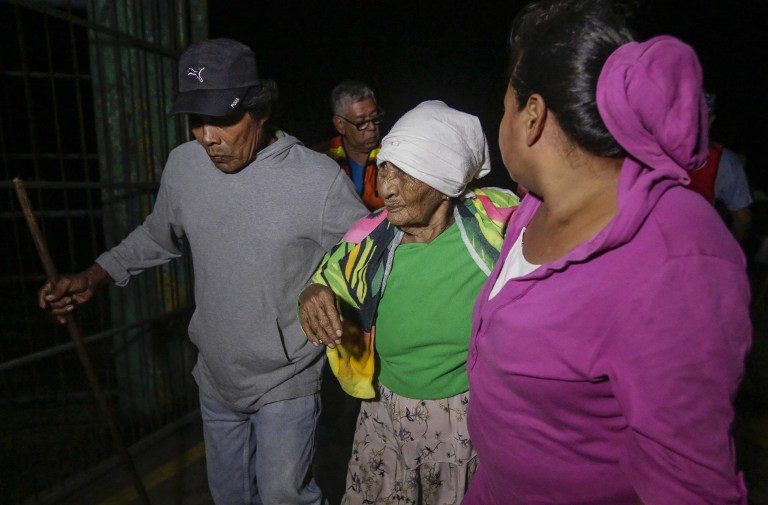SUMMARY
This is AI generated summarization, which may have errors. For context, always refer to the full article.

BLUEFIELDS, Nicaragua – A powerful hurricane churned toward Nicaragua and Costa Rica on Thursday, November 24, with freight-train winds and heavy rains expected to trigger dangerous floods and mudslides.
Both countries have ordered evacuations along parts of their Caribbean coasts, closed schools and mobilized emergency crews.
Costa Rica declared a national emergency late Wednesday, sending its non-essential public workers home for two days and urging private companies to do likewise. Half the country was under red alert.
It will be the first time Costa Rica has taken a direct hit from a hurricane since records began in 1851.
“Let me be clear: the hurricane is potentially highly destructive,” Costa Rican President Luis Guilermo Solis warned in a broadcast late Wednesday.
“We hope no one gets hurt, but that is why we must be prepared, and follow the authorities’ orders.”
Hurricane Otto, which had built up strength while sitting offshore in the Caribbean, was packing winds of 165 kilometers (105 miles) per hour, the US National Hurricane Center said.
“Some additional strengthening is possible before landfall,” expected within hours, it said in a bulletin.
Panic buying
The main Caribbean coastal cities in Nicaragua and Costa Rica – Bluefields and Limon, respectively – were calm early Thursday, just before Otto was to make landfall.
Residents had bought up bottled water, battery-powered lamps and plastic bags in preparation for the storm and the possibly of spending the following days without electricity.
Otto was projected to slowly pass along the Nicaragua-Costa Rica border, a mostly rural path that would miss the two countries’ inland capitals.
But the very heavy rain it was bringing with it “will likely result in life-threatening flash floods and mudslides,” according to the US hurricane center.
There was concern among residents of Bluefields, a Nicaraguan city of 45,000 inhabitants.
“I’m expecting it won’t hit Bluefields directly,” shopkeeper Elmer Jackson said by telephone on Wednesday. But he said it was “worrying” that the hurricane’s path could change. “It could go in any direction.”
Some Nicaraguans further south were crossing the nearby border into Costa Rica, hoping it would be safer there, according to locals.
Otto has already proved deadly in Panama, where its outer band of rains and wind caused a mudslide that killed two people on Tuesday, brought down a tree that crushed a nine-year-old boy in a car in the capital, and drowned an 18-year-old swept away by the Utive River.
Evacuations
Costa Rican officials met early Thursday to evaluate preparations.
“We are doing everything necessary,” Solis said afterward, adding that there were no shortages of fuel or water.
The authorities have ordered the evacuation of more than 4,000 people along the sparsely inhabited northern half of Costa Rica’s Caribbean coast.
But some were defiantly staying.
“Some people don’t want to leave their homes, leave all their possessions, their animals,” police officer Christian Rodriguez told the Costa Rican newspaper La Nacion in the village of Batan, close to the Caribbean port city of Limon.
One woman who did evacuate her home near the village of Barra del Colorado, Teresa Romero, 52, told AFP that around 10 male locals had refused to leave. She was taking shelter in a church near the inland capital of San Jose.
The high winds and heavy rains could devastate crops – a big blow especially in Nicaragua, one of the poorest countries in Latin America.
Otto “could seriously jeopardize food security for small farmers who rely on maize (corn), beans, cocoa, honey, coffee and livestock for their livelihoods” in Nicaragua, Jennifer Zapata, a regional director for Heifer International, a US-based poverty-fighting charity, said in a statement.
Otto is a rare, late-appearing hurricane in the Atlantic storm season, which runs from June to the end of November.
It is also on an unusually southern trajectory.
A previous, far-stronger hurricane, Matthew, devastated parts of southern Haiti early last month, killing 546 people and leaving nearly 175,000 homeless. – Rappler.com
Add a comment
How does this make you feel?
There are no comments yet. Add your comment to start the conversation.